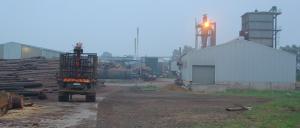 |
Sawmilling IndustryThe saw milling industry in KwaZulu-Natal is dispersed
throughout the timber producing regions of the province.
Sawmilling enterprises are located at Greytown, Sevenoaks,
Weza, Creighton, Dalton, Richmond, Kwambonambi, Vryheid
and other points in the timber areas.
Definitions of different types of sawmills are:
- Formal Sawmill: Log intake of not less than 15,000
m³ per annum, increasing to the largest mill in the
country of ±250,000 m³ per annum. These mills
dry the lumber and supply SANS (SABS) grade, structural and
appearance grade timber. They are location bound, operate
throughout the year, and supply 66% of the sawn timber
market.

Sawmill
|
- Low Cost Mills (LCM.s): These are mills which have been
upgraded from Bushmills, have become location bound and
work throughout the year, normally having kilns and
serving the appearance grade market with some of their
production. They accounted for 27% of the market in
2003.
- Bushmill: These mills are highly mobile, often moving
to burnt plantations. They usually supply the local
Community with wet or air dried timber at a low price, and
also produce pallet and cable drum timber for the nearest
market, and account for 7% of the market.
The sawmills produce sawn lumber, planks, mining timber,
and chips and pulp.
The input materials are mature pine and eucalyptus
species, with limited amounts of other timber species. The
input materials are usually sourced from the closest
possible forests, and are almost all received on road.
The outputs from all categories of sawmills are usually
delivered by road, even to mines and inland destinations.
A small amount of sawn timber is exported and imported
through the port of Durban.
Woodchip is produced by sawmills as a by-product, and is
usually sent by road to the bulk facilities at Richards
Bay or Durban.
The estimated outputs of the saw milling industry in KZN
is approximately 66,000–100,000 tons per annum of
sawn timber, which is transported by road.
|
 |



